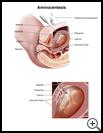
Amniocentesis Test during Pregnancy: Brief Version
________________________________________________________________________
KEY POINTS
- Amniocentesis is a test that may be done during pregnancy to check the health of your baby.
- Your provider will put a thin needle into your belly to get a small amount of fluid from the bag that surrounds the baby.
- The test provides information about your baby and also can help find problems that may need treatment.
________________________________________________________________________
What is amniocentesis?
Amniocentesis is a test done to check the health of your baby while you are pregnant. Your baby grows in your uterus, in a special bag of waters called the amniotic sac. The fluid in this sac is tested to check for different kinds of problems.
When is it used?
The test may be done to check for problems with the baby’s genes when you are 15 to 18 weeks pregnant. If the baby may need to be born early, the test may be done later in pregnancy to see if the baby’s lungs are strong enough. The test may also be done during pregnancy to check for infection inside the womb.
How do I get ready for this test?
Follow the instructions your healthcare provider gives you.
What happens during the test?
A long needle is put through your belly into the uterus. Your healthcare provider will use ultrasound to help guide the needle. Your provider will use the needle to take some fluid out for tests.
What happens after the test?
You will be watched for a little while. Then you can go home. You should rest for about 24 hours after the test.
Ask your healthcare provider:
- How and when you will get your test results
- How long it will take to recover
- If there are activities you should avoid and when you can return to your normal activities
- How to take care of yourself at home
- What symptoms or problems you should watch for and what to do if you have them
Make sure you know when you should come back for a checkup. Keep all appointments for provider visits or tests.
What are the risks of this test?
There is risk with every treatment or procedure. Most women don’t have any problems from this test. Problems that sometimes happen are:
- You may have infection or bleeding.
- The needle may harm the baby, placenta, or umbilical cord.
- You may have premature breaking (rupture) of the amniotic sac.
- You may have premature contractions or labor.
- You may have a miscarriage.
Ask your healthcare provider how these risks apply to you. Be sure to discuss any other questions or concerns that you may have.

